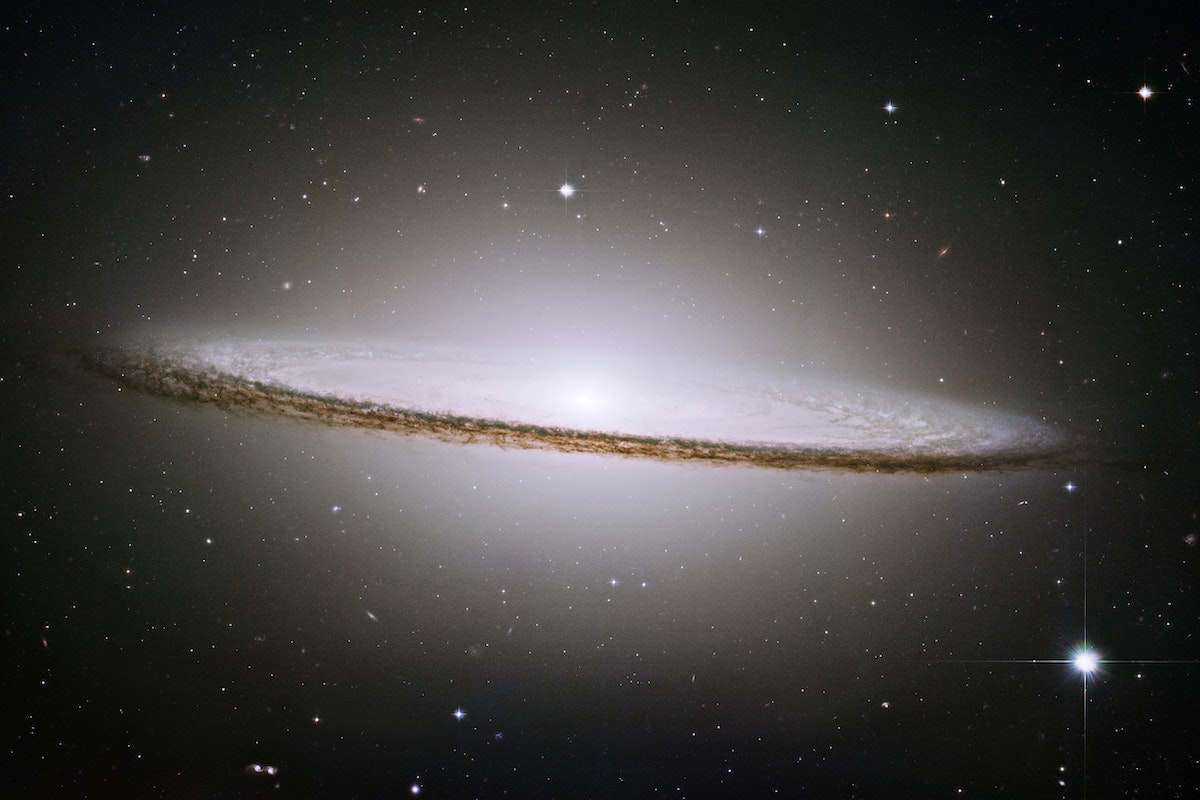The Sombrero Galaxy, also known as Messier 104, is a spiral galaxy located in the constellation Virgo, about 28 million light-years away from Earth. This magnificent galaxy has been the subject of fascination for astronomers for centuries, and it continues to be a source of inspiration and wonder.
The Sombrero Galaxy is named after its striking resemblance to a sombrero hat, with a broad, circular disk and a prominent bulge at the centre. The disk is made up of billions of stars, dust, and gas, and it spans approximately 50,000 light-years across. The bulge at the centre is home to a supermassive black hole that has a mass equivalent to one billion suns.
The Sombrero Galaxy is classified as a spiral galaxy, but it is somewhat unusual in its appearance. Unlike other spiral galaxies that have a central bar structure, the Sombrero Galaxy has a smooth, rounded bulge. This has led some astronomers to speculate that the Sombrero Galaxy may have formed through the merger of two galaxies, one of which was a disk galaxy and the other was an elliptical galaxy.
The discovery of the Sombrero Galaxy is credited to the French astronomer Pierre Méchain, who first observed it in 1781. However, it was the famous astronomer Charles Messier who included it in his catalogue of celestial objects in 1784. Messier initially thought that the Sombrero Galaxy was a nebula, but he later realised that it was a distant galaxy. It wasn’t until the 20th century that astronomers began to fully appreciate the significance of the Sombrero Galaxy and its unique features.
One of the most fascinating aspects of the Sombrero Galaxy is its central black hole. This supermassive black hole is believed to be the driving force behind the intense radiation emanating from the centre of the galaxy. The black hole also plays a crucial role in the formation and evolution of the galaxy. As stars and gas swirl around the black hole, they are heated up and ejected into space, which helps to create new stars and maintain the galaxy’s overall structure.
The Sombrero Galaxy has also been the subject of intense study by astronomers who are interested in understanding the mysteries of our universe. In particular, the Sombrero Galaxy has been used as a laboratory for studying dark matter, a mysterious substance that is believed to make up most of the mass in the universe. By studying the way that the stars in the Sombrero Galaxy move, astronomers have been able to estimate the amount of dark matter that is present in the galaxy.
In conclusion, the Sombrero Galaxy is a fascinating object that continues to capture the imagination of astronomers and space enthusiasts alike. Its unique features, including its central black hole and smooth bulge, make it a valuable laboratory for studying the mysteries of our universe. As our technology advances, we will no doubt continue to learn more about this beautiful and enigmatic galaxy that lies beyond our reach.
Features of the Sombrero Galaxy
The Sombrero Galaxy, also known as Messier 104, is a fascinating object that has captured the attention of astronomers and space enthusiasts for centuries. Here are some of the most notable features of the Sombrero Galaxy:
Distinctive appearance
The Sombrero Galaxy is named after its distinctive appearance, which resembles a sombrero hat. It has a broad, circular disk with a prominent central bulge that gives it a distinctive shape.
Spiral arms
The disk of the Sombrero Galaxy is composed of a series of spiral arms that are made up of gas, dust, and stars. These arms are thought to be the primary sites of star formation in the galaxy.
Supermassive black hole
The Sombrero Galaxy has a supermassive black hole at its centre that has a mass equivalent to one billion suns. This black hole is believed to be the source of the intense radiation that emanates from the centre of the galaxy.
Smooth bulge
Unlike other spiral galaxies, the Sombrero Galaxy has a smooth, rounded bulge at its centre instead of a central bar structure. This has led some astronomers to speculate that the galaxy may have formed through the merger of two galaxies, one of which was a disk galaxy and the other was an elliptical galaxy.
Dark matter
The Sombrero Galaxy has been studied extensively by astronomers who are interested in understanding the nature of dark matter, a mysterious substance that is believed to make up most of the mass in the universe. By studying the way that the stars in the Sombrero Galaxy move, astronomers have been able to estimate the amount of dark matter that is present in the galaxy.
Distance from Earth
The Sombrero Galaxy is located about 28 million light-years away from Earth, making it relatively close in astronomical terms. However, this distance is still too far to allow for detailed observations of individual stars or other objects within the galaxy.
Overall, the Sombrero Galaxy is a fascinating object that continues to captivate astronomers and space enthusiasts alike. Its unique features, including its distinctive shape, supermassive black hole, and smooth bulge, make it a valuable laboratory for studying the mysteries of our universe.
Finding the Sombrero Galaxy
The Sombrero Galaxy, also known as Messier 104, is a stunning spiral galaxy located in the constellation Virgo, about 28 million light-years away from Earth. Although it is not visible to the naked eye, it is still possible to observe the Sombrero Galaxy with the help of telescopes and other astronomical instruments.
Here are some tips for finding the Sombrero Galaxy:
- Find the constellation Virgo: The Sombrero Galaxy is located within the constellation Virgo, which can be found in the southern sky during spring and summer in the northern hemisphere. Look for the brightest star in the constellation, Spica, and use it as a guide to locate the rest of the constellation.
- Use a telescope: The Sombrero Galaxy is too faint to be seen with the naked eye, so you will need a telescope to observe it. A telescope with an aperture of at least 6 inches (15 centimeters) is recommended to see the galaxy clearly.
- Look for a smudge in the sky: Once you have located the constellation Virgo, look for a smudge in the sky that resembles a small, fuzzy ball. This is the Sombrero Galaxy. It is best observed from a dark location with minimal light pollution.
- Use a star chart or astronomy app: If you are having trouble locating the Sombrero Galaxy, you can use a star chart or astronomy app to help you find it. These resources can show you the exact location of the galaxy in relation to the other stars and constellations in the sky.
Observing the Sombrero Galaxy can be a rewarding experience for amateur and professional astronomers alike. Its unique features, including its central bulge and supermassive black hole, make it a fascinating object to study and admire.

